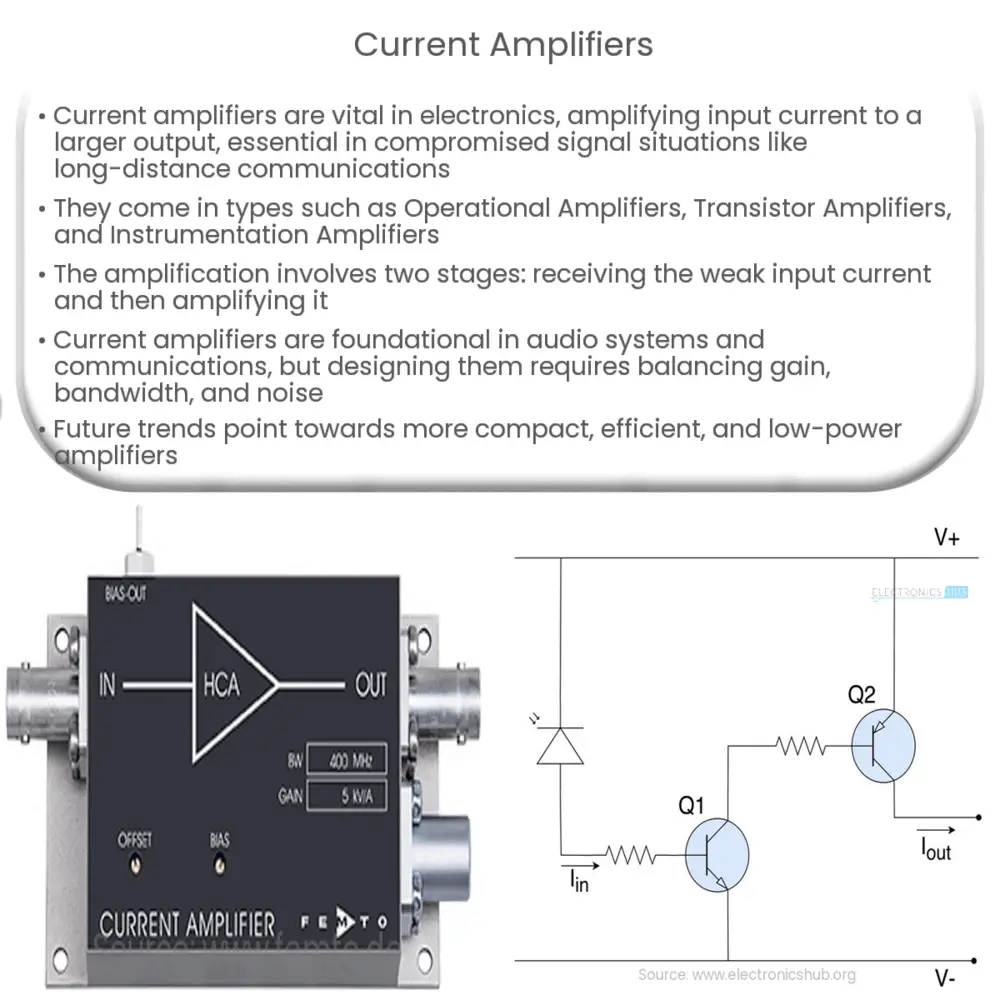Explore the fundamentals of current amplifiers, their types, working principles, applications, design considerations, and future trends.

Introduction to Current Amplifiers
Current amplifiers play a critical role in electronics, serving as an essential component in a wide variety of applications. They function by taking a small input current and producing a larger output current, effectively ‘amplifying’ the signal. This is particularly useful in situations where signal strength is compromised, such as long-distance communications and high-performance audio systems.
Types of Current Amplifiers
- Operational Amplifiers (Op-Amps): Op-amps are high-gain electronic voltage amplifiers with differential input and usually a single-ended output. They can be configured to work as current amplifiers.
- Transistor Amplifiers: These are amplifiers that use a transistor, a semiconductor device, to increase the power of a signal.
- Instrumentation Amplifiers: Instrumentation amplifiers are designed to offer precise, stable, gain while simultaneously rejecting any common mode signals.
Working Principle of Current Amplifiers
The functionality of a current amplifier is based on the principle of using a small input current to control a larger output current. This means that the signal from the input is used to modulate the current in the output circuit, providing an amplified version of the original signal.
The amplification process generally involves two stages:
- Input Stage: In this stage, the input current signal is received. This signal is often weak and needs to be amplified for further processing.
- Amplification Stage: In the amplification stage, the weak input signal is amplified to produce a stronger output signal.
Applications of Current Amplifiers
Due to their unique ability to amplify signals, current amplifiers find wide-ranging applications. These include:
- Audio Systems: They are used in audio systems to increase the magnitude of audio signals, ensuring the sound is loud enough.
- Communications: In telecommunication systems, they amplify the signals for long-distance transmission.
This comprehensive understanding of current amplifiers — their types, the principles behind their operation, and their applications — provides a solid foundation to further delve into their designs, benefits, and challenges.
Design Considerations for Current Amplifiers
When designing current amplifiers, several important factors come into play:
- Gain: The amplifier’s gain, or the ratio of output to input, is one of the most important specifications. It is usually the primary objective of using an amplifier.
- Bandwidth: An amplifier’s bandwidth is the range of frequencies over which the amplifier can adequately amplify the signal. This is particularly important in audio and communication systems.
- Noise: Noise in an amplifier refers to the random and unwanted signals that are added to the output. Minimizing noise is critical to maintaining signal integrity.
Benefits and Challenges of Current Amplifiers
Current amplifiers have several notable benefits. Primarily, they help overcome signal degradation and loss over long distances, thus facilitating efficient communication. Additionally, they are essential in audio systems for increasing the volume of audio signals, thereby improving user experiences.
However, they also come with certain challenges. Designing a good current amplifier involves striking a balance between gain, bandwidth, and noise. Furthermore, current amplifiers can suffer from issues like distortion, which can alter the quality of the output signal.
Future Trends in Current Amplifiers
Looking ahead, advancements in technology promise exciting developments in the domain of current amplifiers. Continued miniaturization could lead to more compact and efficient amplifiers. Additionally, there’s an increasing interest in the development of low-power amplifiers for portable and wireless devices, given the growing importance of mobility in today’s world.
Conclusion
In conclusion, current amplifiers are indispensable tools in the realm of electronics. They form the backbone of numerous devices and systems, from audio systems to long-distance communication networks. Despite their challenges, with ongoing technological advancements, their efficiency, compactness, and performance will only continue to improve. Understanding their workings, applications, and the considerations needed in their design is crucial for anyone seeking to delve into the fascinating field of electronics.

